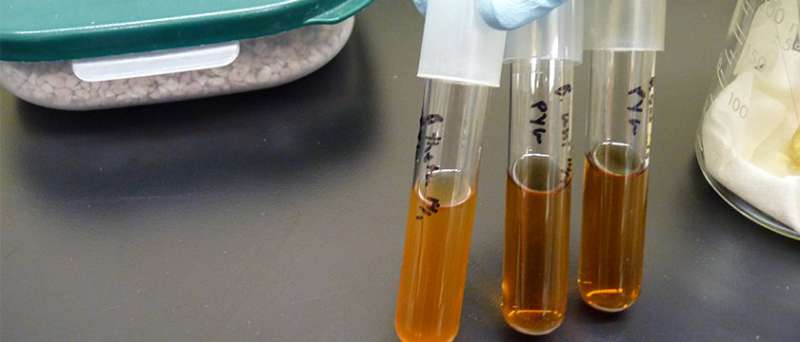Culturing gut bacteria in the lab (shown in these test tubes) allows researchers to determine which genes in the genomes of bacteria are activated and discover new enzymes that digest rare substrates like agarose. Credit: Wade Abbott
Cattle on the Prairies are hundreds of kilometres from the coast and yet it's possible that seaweed could make its way into their diet as an additive.
"Seaweed is an incredible opportunity. It is a sustainable feedstock. It grows rapidly, it doesn't require arable land or fresh water to grow," said Wade Abbott, research scientist at Agriculture and Agi-Food Canada's Lethbridge Research and Development Centre.
If more livestock feed came from seaweed, less would have to be produced from traditional crops, such as corn.
"It's rich in micro-nutrients. There are no lignins so it's easy to digest. The list goes on and on," said Abbott, in an interview.
Abbott and Alisdair Boraston, a University of Victoria professor of biochemistry and microbiology, led a team of scientists to determine exactly how the sugars in red seaweed are released when broken down or metabolized in the human gut.
It may seem like a leap to go from the human gut to that of cattle, but Abbott explained that by understanding the human gut microbiome, or microorganisms, and the microbiome's ability to use the sugars found in seaweed in its symbiotic relationship with the host, he sees potential to expand what is now a limited use of algae products.
"We would like to use rare sugars such as seaweed glycans for application in livestock to promote growth of bacteria that are very specific in their metabolism. Because there are very few bacteria that can digest the agarose, or seaweed polysaccharides, perhaps we can use seaweed polysaccharides to select for bacteria that have beneficial properties, to try to shape the community structure of the bacteria that live in the intestine of cattle," said Abbott.
The scientists' interest in seaweed can be traced back to their respective childhoods, growing up on the West Coast.
"At various times in the year, you would see these massive piles of seaweed. Then they would disappear. Where does all this seaweed go? People hadn't really looked at it. The assumption was that bacteria found in the ocean did the job but exactly how bacteria cope with these really bizarre sugars that you find in seaweed biomass wasn't known," said Boraston, in an interview.
It wasn't until he established his laboratory in the Department of Biochemistry and Microbiology at the University of Victoria that Boraston started putting the pieces together and began to explore how microbes metabolize seaweed polysaccharide (a type of carbohydrate or sugar).
The hypothetical link between this metabolic capability and human health was originally posed by Dr. Jan-Hendrik Hehemann, who worked in Boraston's lab specifically to explore this idea.
Elaborating upon this, Abbott and Boraston began to collaborate on the puzzle of how other seaweed sugars are broken down by examining the molecular structures and functions of proteins from a human gut bacterium that can eat a common seaweed component, agarose, which is a polysaccharide found in red seaweed.
Using the crystallography beamline at the Canadian Light Source, they solved the structures of four different enzymes that digest agarose.
"These findings contribute to a growing paradigm shift in our understanding of how the distal gut microbiome adapts to the chemical diversity of indigestible dietary carbohydrates," according to their paper, "Molecular basis of an agarose metabolic pathway acquired by a human intestinal symbiont," published this spring in Nature Communications.
In talking about their work, the researchers compared the digesting of seaweed to other types of food. A human digestive system responds according to the type of sugar that is eaten. Many of the complex carbohydrates found in fruits and vegetables are metabolized by bacteria that colonize the human intestine.
"It doesn't seem to matter what kinds of carbohydrate we consume, there is a bacteria out there somewhere in nature and most likely in your intestine that can digest it and convert it into energy that you can use," said Abbott.
For some unknown reason, the bacteria that breaks down red seaweed is not universal in people but is found primarily in the guts of those living in Asia and parts of Northern Europe and America, which may be inherited from their ancestors that lived along the along coasts where seaweed is part of the diet.
As for Boraston's interests, members of animal gut microbiomes make excellent model systems for studying polysaccharide-specific metabolic pathways.
"My role in this project was really drilling down deep into how the enzymes do their jobs," said Boraston.
Through efforts like this, however, he sees the potential to enable the manipulation of microbiome composition.
"This opens the opportunity to engineer the composition of microbiomes. If you had a particular probiotic bacterium that you were trying to select for and keep it in the microbiome, you could use something like agarose metabolism in a diet to keep that positive good bacterium as a member of the microbiome."
Several species of red algae thrive on the coasts of the Pacific Northwest creating the potential for a multi-million dollar industry aimed at improving animal or human health.
"We have an opportunity in Canada to expand this industry. You look at countries in Asia, it's a massive industry and they export a lot of seaweed products that are consumed all over the world. It's definitely something that people don't think enough above but when you consider our coastlines, it's an opportunity to exploit that," said Abbott.
More information: Benjamin Pluvinage et al. Molecular basis of an agarose metabolic pathway acquired by a human intestinal symbiont, Nature Communications (2018). DOI: 10.1038/s41467-018-03366-x
Journal information: Nature Communications
Provided by Canadian Light Source






















